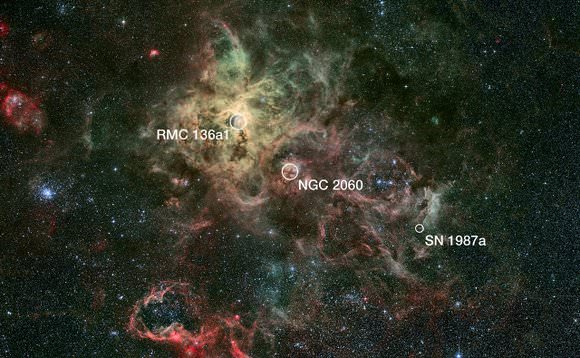[/caption]
Hubble has edged in close to the Tarantula Nebula, peering into its bright center of ionized gases, dust and still-forming stars. The Tarantula is already a go-to celestial marvel, because its hydrogen-fueled young stars shine with such intense ultraviolet light that they ionize and redden the surrounding gas — making the nebula visible without a telescope for Earth-bound observers 170,000 light-years away. The new image may make this popular beacon, in our neighboring galaxy the Large Magellanic Cloud, even more famous.

The wispy arms of the Tarantula Nebula (RA 05h 38m 38s dec -69° 05.7?) were originally thought to resemble spindly spider legs, giving the nebula its unusual name. The part of the nebula visible in the new image is criss-crossed with tendrils of dust and gas churned up by recent supernovae. These remnants include NGC 2060, visible above and to the left of the center of the image, which contains the brightest known pulsar.
The tarantula’s bite goes beyond NGC 2060. Near the edge of the nebula, outside the frame, below and to the right, lie the remains of supernova SN 1987a, the closest supernova to Earth to be observed since the invention of telescopes in the 17th century. Hubble and other telescopes have been returning to spy on this stellar explosion regularly since it blew up in 1987, and each subsequent visit shows an expanding shockwave lighting up the gas around the star, creating a pearl necklace of glowing pockets of gas around the remains of the star. SN 1987a is visible in wide field images of the nebula, such as that taken by the MPG/ESO 2.2-meter telescope.
A compact and extremely bright star cluster called RMC 136 lies above and to the left of this field of view, providing much of the radiation that powers the multi-coloured glow. Until recently, astronomers debated whether the source of the intense light was a tightly bound cluster of stars, or perhaps an unknown type of super-star thousands of times bigger than the sun. It is only in the last 20 years, with the fine detail revealed by Hubble and the latest generation of ground-based telescopes, that astronomers have been able to conclusively prove that it is, indeed, a star cluster.
But even if the Tarantula Nebula doesn’t contain this hypothetical super-star, it still hosts some extreme phenomena, making it a popular target for telescopes. Within the bright star cluster lies star RMC 136a1, which was recently found to be the heaviest ever discovered: the star’s mass when it was born was around 300 times that of the sun. This heavyweight is challenging astronomers’ theories of star formation, smashing through the upper limit they thought existed on star mass.
Source: ESA press release at the Hubble site. See also previous releases on the Large Magellanic Cloud and RMC 136.


Stunning! Slight improvement on the view through my 12″…